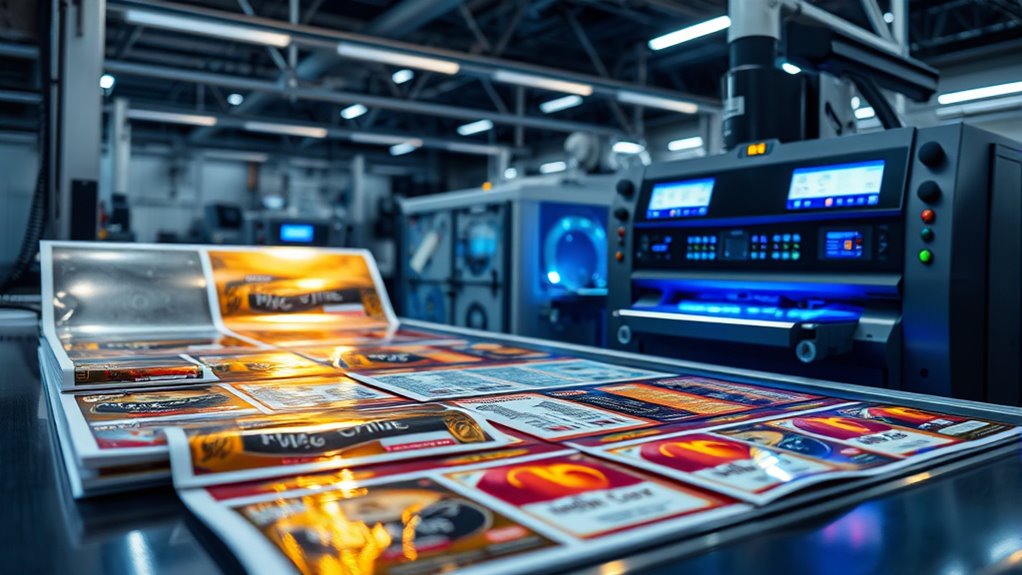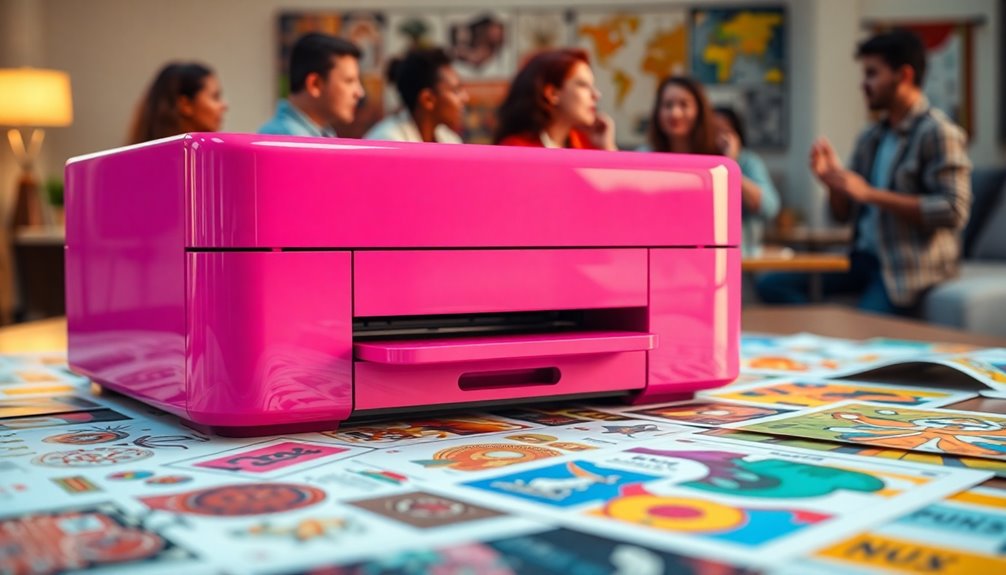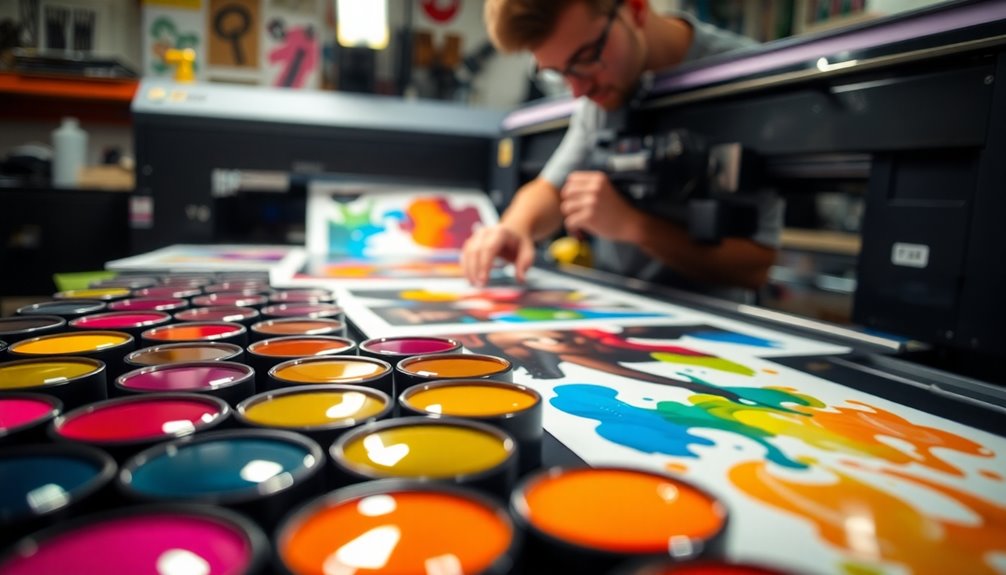In 2025, expect label printing and finishing to focus heavily on eco-friendly materials, such as biodegradable inks and recycled substrates, while advanced digital technologies enable quick, high-quality, short-run customization. Smart labels with IoT features, augmented reality, and interactive QR codes will engage consumers like never before. Enhanced finishing techniques will add tactile appeal, and automation will streamline production. Continuing with these trends will reveal how innovation and sustainability are shaping the future of labels.
Key Takeaways
- Sustainable materials and eco-friendly finishing techniques like embossing, spot UV, and biodegradable inks will dominate label production.
- Digital printing advancements enable high-quality, short-run, and personalized labels with rapid turnaround times.
- Brands will leverage interactive smart labels, QR codes, and AR to enhance consumer engagement and storytelling.
- Automation and Industry 4.0 technologies will streamline workflows, improve quality, and support real-time data integration.
- Visual and tactile finishes will be used to create immersive, memorable branding experiences that stand out on shelves.
Embracing Sustainable Materials and Eco-Friendly Practices

As sustainability becomes a top priority, label printers are increasingly turning to eco-friendly materials and practices. You can reduce environmental impact by switching to biodegradable inks, which break down naturally and lessen pollution. Using recycled substrates, such as post-consumer paper and plastic, helps conserve resources and minimizes waste. These materials not only support your company’s green initiatives but also appeal to eco-conscious consumers. Implementing sustainable practices can involve sourcing dyes that are less toxic or adopting water-based inks over solvent-based options. By prioritizing biodegradable inks and recycled substrates, you demonstrate a commitment to environmental responsibility. Incorporating natural materials like wood or linen into packaging and branding can further enhance your eco-friendly image and appeal to environmentally aware customers. This shift can also lead to cost savings over time through more efficient resource use, benefiting your bottom line while supporting the planet. Recognizing the importance of sustainable supply chains can help ensure your entire process aligns with eco-friendly standards. This shift not only benefits the planet but also enhances your brand’s reputation, aligning your business with growing consumer demand for eco-friendly products.
Advancements in Digital Printing Technologies

Digital printing technologies are revolutionizing label production by offering faster, more flexible, and cost-effective solutions. Inkjet innovation leads the way, enabling high-quality images with vibrant colors and sharp details. Improved color management systems guarantee consistent, accurate hues across batches, reducing waste and rework. You’ll notice:
Digital printing transforms label production with faster, flexible, and cost-effective solutions.
- Rapid production speeds that meet tight deadlines
- Enhanced resolution for detailed graphics
- On-demand printing reduces inventory costs
- Greater flexibility for small runs and prototypes
These advancements allow you to customize labels easily while maintaining high standards. As digital presses become more sophisticated, they support diverse substrates and finishing options. Embracing these innovations means you’ll stay competitive, streamline workflows, and deliver visually striking labels that resonate with your audience.
Personalization and Customization at Scale
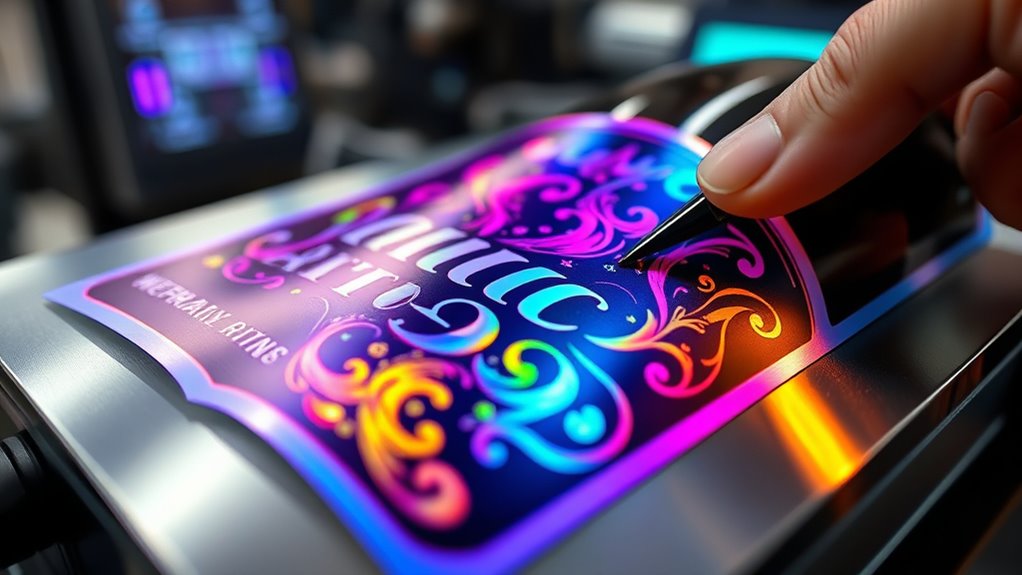
With advancements in printing technologies, achieving personalization and customization at scale has become more practical and affordable than ever. You can now implement the latest customization trends to create unique labels tailored to individual preferences or target specific customer segments. Personalization strategies such as variable data printing and digital presses enable rapid, cost-effective production of customized labels without sacrificing efficiency. This shift allows you to offer highly personalized products, increasing customer engagement and loyalty. Additionally, incorporating label printing concepts into label design can enhance product appeal by highlighting targeted skincare benefits. As a result, your label printing process can adapt seamlessly to fluctuating demand and diverse market needs. Leveraging printing technology can further optimize your production workflows and improve turnaround times. The integration of innovative home theatre projectors can also inspire new ways to showcase your products or create immersive customer experiences. Embracing these innovative approaches, including digital printing, ensures you stay ahead of competitors by providing tailored solutions at scale, making your offerings more appealing and relevant in a rapidly evolving marketplace.
Integration of Smart Labels and IoT Capabilities
Smart labels with IoT capabilities are transforming how you track products through the supply chain, providing real-time updates and increased transparency. They also enable interactive experiences that engage consumers directly with the product. Embracing this technology can streamline operations and boost customer engagement simultaneously. Additionally, integrating high-quality home decor and gift ideas into smart labeling systems can enhance the presentation and personalization of products, making them more appealing to consumers. Recognizing relationship dynamics can help in tailoring customer interactions and improving product presentation strategies.
Enhanced Supply Chain Tracking
As supply chains become more complex, integrating smart labels and IoT capabilities offers a significant advantage in tracking and transparency. You’ll gain real-time data that enhances supply chain transparency and improves inventory visibility. This integration helps you monitor products from origin to delivery, reducing delays and theft. With smart labels, you can quickly identify issues and respond proactively. Modern Hyundai Tuning techniques can be adapted to improve the performance and reliability of your logistics vehicles, further supporting your supply chain efficiency. Implementing advanced tracking methods can also optimize route planning and reduce operational costs, while ensuring that product safety and quality are maintained throughout the process. Incorporating Gold IRA strategies can diversify your investment portfolio and provide a hedge against economic uncertainties, complementing your supply chain investments.
Interactive Product Engagement
Interactive product engagement is transforming how you connect with brands by leveraging smart labels and IoT capabilities. With interactive packaging, products become more than just items on a shelf—they turn into digital touchpoints for customer interaction. Smart labels can provide real-time information, personalized offers, and immersive experiences that deepen your engagement. This integration of IoT enables brands to gather valuable data on how you interact with their products, creating opportunities for tailored marketing and improved customer service. As a result, your experience becomes more dynamic and memorable, fostering brand loyalty. Additionally, mindfulness practices can help consumers better appreciate and engage with these innovative experiences, enhancing their overall satisfaction. Enhanced engagement strategies driven by IoT can also lead to a more sustainable approach by reducing waste and improving product lifecycle management. Incorporating market trend analysis allows brands to stay ahead of consumer preferences and technological advancements. Furthermore, advances in AI-driven solutions are enhancing the personalization and efficiency of these interactive experiences. By embracing these innovations, manufacturers and retailers can enhance digital customer interaction, making shopping more engaging and informative. Interactive product engagement is set to redefine how you experience and connect with brands in 2025.
Enhanced Finishing Techniques for Visual Impact

Enhanced finishing techniques can make your labels stand out on the shelf. Embossing and debossing add tactile dimension, while spot UV and gloss coats create striking visual contrast. Incorporating these methods can elevate your label’s overall impact and appeal. Additionally, selecting the right food safety practices ensures the longevity and quality of your packaging. Implementing proper sterilization techniques further guarantees the safety and integrity of your labels over time.
Embossing and Debossing Effects
Embossing and debossing techniques are gaining popularity for their ability to create striking visual and tactile effects on labels. These methods add depth and texture, making your packaging stand out. With embossing effects, you can elevate logos or design elements, giving them a raised, premium feel. Debossing techniques, on the other hand, create recessed impressions that add sophistication and subtlety. You might consider combining these effects with metallic foils or matte finishes for even more impact. Here are some key points:
- Use embossing effects to highlight logos or key design features
- Debossing techniques provide a subtle, elegant look
- Combining with other finishes enhances tactile appeal
- Choose the right depth for the desired visual impact
This approach helps create memorable labels that catch the eye and engage consumers.
Spot UV and Gloss Coats
Spot UV and gloss coats are powerful finishing techniques that can dramatically boost the visual appeal of your labels. By applying spot UV, you highlight specific areas with a shiny, reflective coating that draws attention and adds depth. Gloss coats, on the other hand, provide an even, high-gloss finish across the entire label, making colors pop and creating a sleek look. These techniques not only enhance aesthetics but also offer protection against scratches and scuffs, increasing durability. Incorporating spot UV and gloss coats allows you to create labels that stand out on shelves and catch consumers’ eyes. Whether you want to emphasize branding elements or add a premium touch, these finishes give your labels a sophisticated, eye-catching finish that appeals to modern consumer preferences.
Automation and Industry 4.0 in Label Production
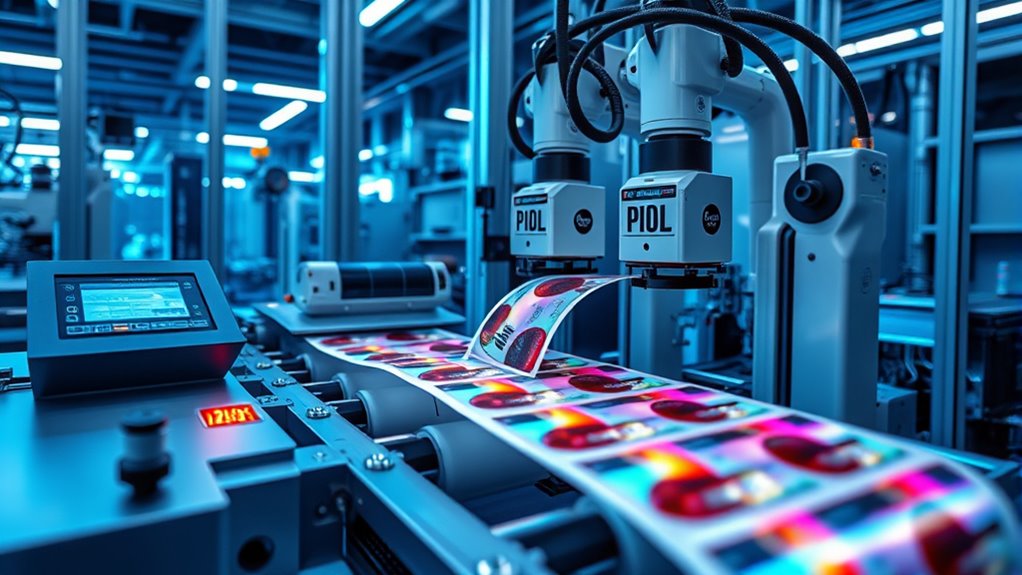
As Industry 4.0 continues to transform manufacturing, automation plays a pivotal role in shaping the future of label production. You’ll see increased use of robotic automation, streamlining tasks like print registration and finishing, reducing errors and downtime. Machine learning algorithms analyze data in real-time, optimizing workflows and predicting maintenance needs before issues arise. This integration accelerates production cycles and enhances quality control. To stay competitive, you’ll adopt systems that:
- Use sensors for real-time process adjustments
- Enable remote monitoring and control
- Automate repetitive tasks for efficiency
- Improve traceability through connected data networks
This shift empowers you to produce personalized labels faster, with higher precision, and at lower costs, all while maintaining consistent quality standards.
Focus on Brand Storytelling Through Innovative Designs
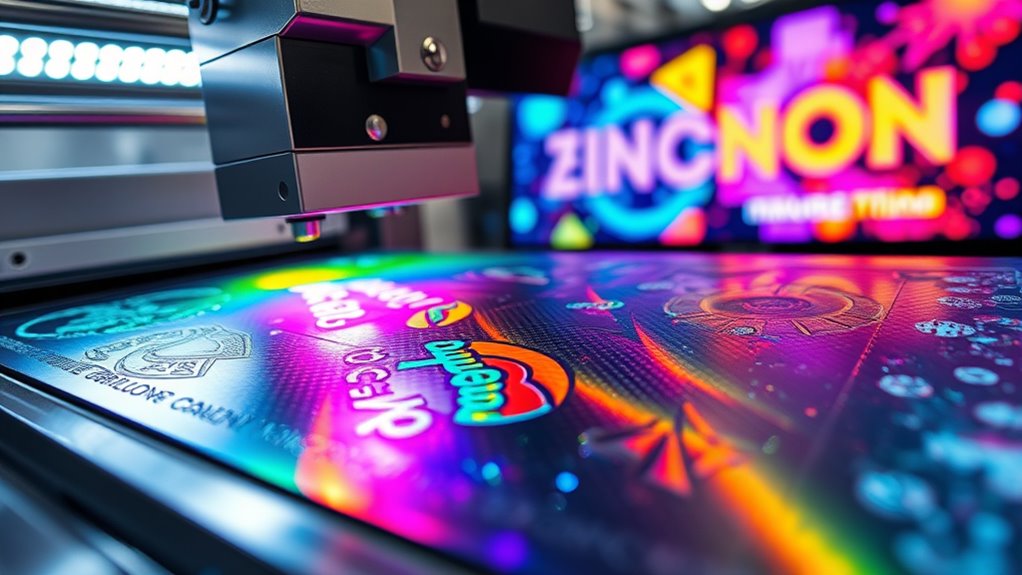
How can your labels become powerful storytellers that resonate with consumers? The storytelling evolution in label design emphasizes creating visual storytelling that captures attention and communicates your brand’s unique narrative. Innovative designs leverage bold graphics, textures, and colors to evoke emotions and deepen consumer connections. By integrating storytelling elements into your labels, you transform them from mere identifiers into compelling brand ambassadors. This approach not only enhances shelf appeal but also helps convey your brand’s values and heritage instantly. To stand out in a crowded marketplace, focus on crafting visual storytelling that aligns with your brand story. As labeling technology advances, you can push creative boundaries, ensuring your labels tell a fascinating story that leaves a lasting impression on your audience.
Adoption of QR Codes and Augmented Reality Features
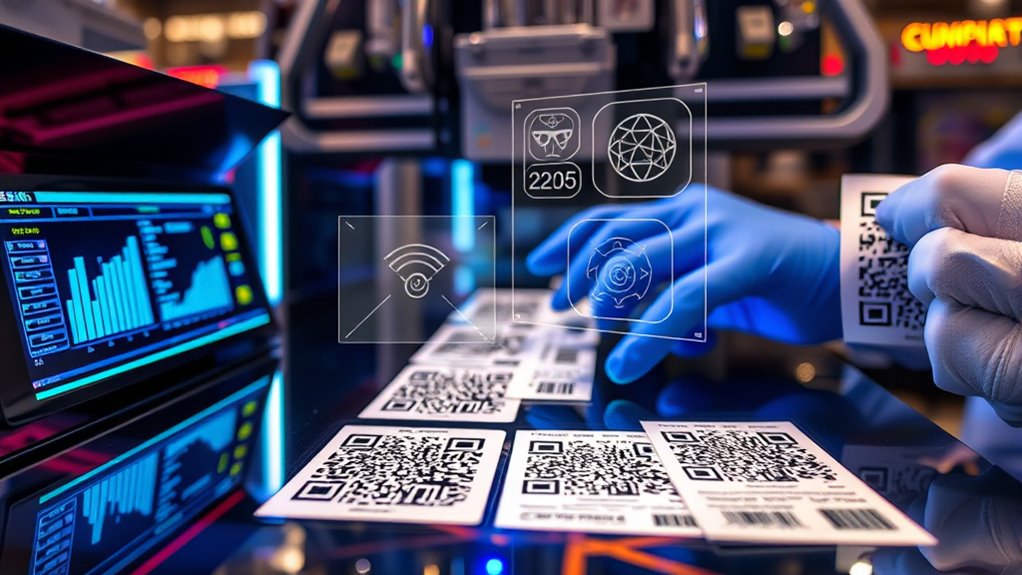
The adoption of QR codes and augmented reality (AR) features is transforming label interaction, offering consumers an immersive brand experience. With QR code integration, you can instantly connect customers to product details, videos, or special offers. Augmented reality features enhance engagement by allowing users to see 3D visuals or interactive content directly on the label. You might notice brands using AR to showcase product origins or demonstrate usage in real time. This technology makes labels more dynamic and memorable.
- Boosts customer engagement through interactive content
- Provides instant access to detailed product info
- Differentiates your brand in a crowded market
- Encourages repeat interactions with innovative features
Growing Demand for Short-Run and On-Demand Printing
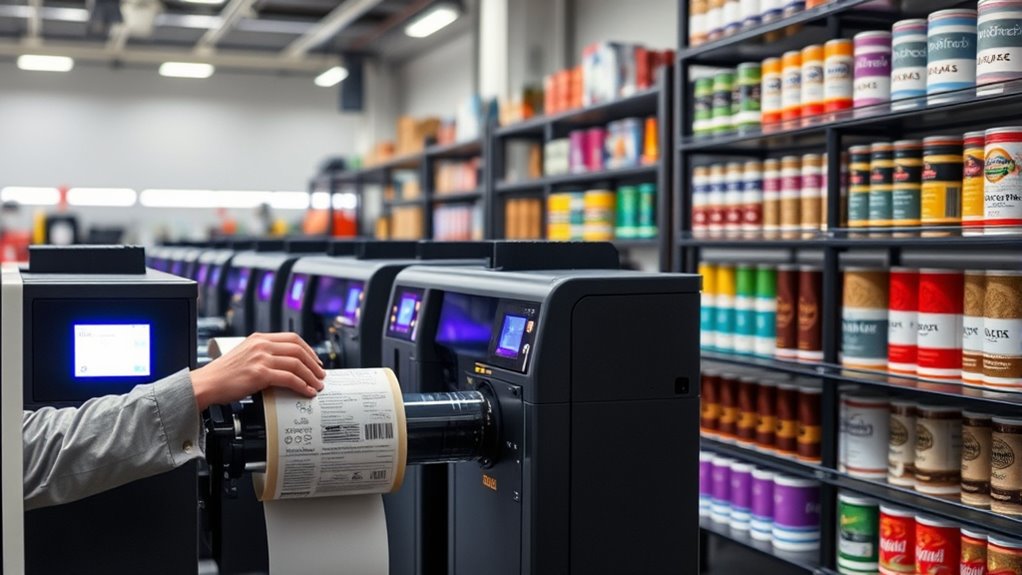
With interactive labels increasingly engaging consumers, brands are seeking more flexible and cost-effective printing options. The growing demand for short-run and on-demand printing drives this shift, allowing brands to quickly adapt to market trends and personalized messaging. Advances in digital workflows streamline production, reducing setup times and enabling rapid turnaround. Material innovations also play a vital role, providing versatile substrates that support variable data and customized designs without sacrificing quality. This combination of digital technology and innovative materials allows for cost-efficient small-batch runs, minimizing waste and inventory costs. As a result, brands can deliver highly targeted, personalized labels on a per-order basis, meeting consumer expectations for uniqueness and immediacy while maintaining high standards of print quality.
Frequently Asked Questions
How Will Regulatory Changes Impact Sustainable Label Printing Practices?
Regulatory changes will push you to prioritize regulatory compliance and adopt sustainable materials in label printing. You’ll need to stay updated on new standards, which may require switching to eco-friendly inks and recyclable substrates. This shift not only helps you meet legal requirements but also enhances your brand’s sustainability image. By embracing these practices, you can reduce environmental impact and stay competitive in a market increasingly driven by eco-conscious consumers.
What Emerging Digital Printing Technologies Are Expected to Dominate in 2025?
You’ll see digital presses and ink innovations leading the way in 2025, transforming label printing. These emerging digital technologies enable faster turnaround times, lower waste, and more customization options. As you explore new solutions, expect advanced digital presses to handle high-quality printing efficiently, while ink innovations improve durability and eco-friendliness. Embracing these advancements helps you stay competitive and adaptable in the evolving label printing landscape.
How Can Small Businesses Leverage Personalization and Customization Effectively?
You can harness personalization strategies to turn your small business into a powerhouse of customer loyalty. By embracing customization trends, you make each product feel tailor-made, creating an irresistible allure that keeps customers coming back for more. Use innovative digital printing tools to easily adapt your labels or packaging, making every order unique. This personal touch can skyrocket your brand’s appeal, building stronger connections and boosting your sales exponentially.
What Are the Main Challenges in Integrating Iot With Label Printing?
When integrating IoT with label printing, you face challenges like automation integration and data security. You need to guarantee your systems communicate smoothly without disrupting existing workflows, which can be complex. Protecting sensitive data from cyber threats is vital, so you must implement robust security measures. By focusing on seamless automation and strong security protocols, you can harness IoT’s benefits while minimizing risks and maximizing efficiency in your label printing processes.
How Will Finishing Techniques Evolve to Enhance Visual and Tactile Appeal?
Imagine 75% of consumers are more likely to buy a product with appealing tactile finishes. You’ll see embossing techniques become more sophisticated, adding depth and texture that make labels stand out. Finishing techniques will evolve to deliver richer visual appeal and tactile experiences, combining metallic foils, matte coatings, and textured embossing. These enhancements will make your labels more engaging, helping your products captivate consumers and boost shelf impact.
Conclusion
As you look ahead to 2025, the future of label printing and finishing is full of exciting innovations. From eco-friendly materials to smart labels with AR features, the possibilities are endless—and just around the corner. Stay tuned, because what’s coming next could transform how you connect with consumers and tell your brand story. Are you ready to embrace the changes that will redefine your printing game? The future’s about to get even more dynamic.

